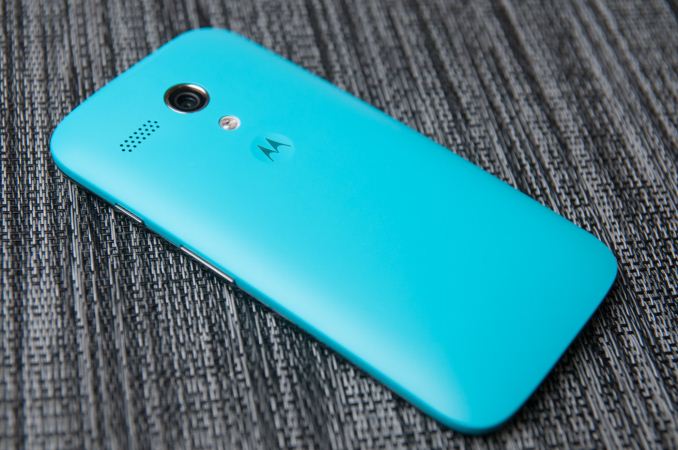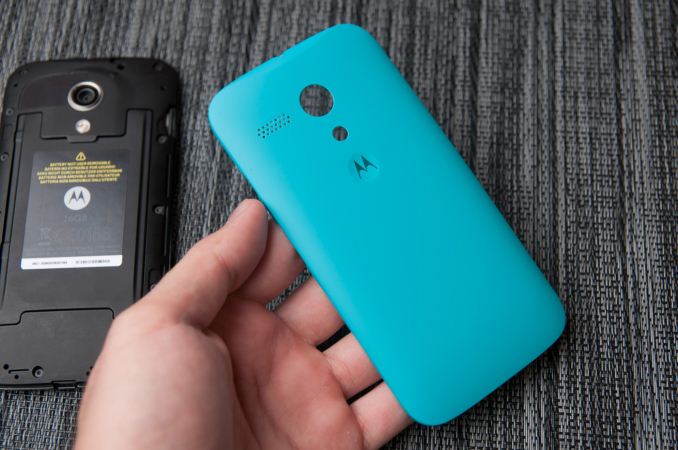Motorola Moto G Review
by Brian Klug on December 18, 2013 2:00 PM EST- Posted in
- Smartphones
- Motorola
- Mobile
- *VA
- Cortex A7
- snapdragon 400
- Moto G
Making an affordable smartphone for the masses that aren’t willing to spend the dime on flagship-tier devices is a pitch I’ve heard a few times. Usually the device starts out great, but software support ends up being negligible from the start, or the device has serious caveats in actual practice. The number of mid to low end phones I’ve seen which promised to be halo devices of the mass market but are stuck running the same software they launched with could fill a few desk drawers.
I’ve been using Moto G as my daily driver since getting it, and absent a few features (camera, LTE, always on voice and display tuning), the device is surprisingly close to offering a similar kind of experience as the Moto X. Form factor is roughly equivalent, it’s like a Moto X that has put on a few pounds and a few millimeters around the edges. The physical differences aren't huge, and I'm glad that Motorola didn't sacrifice anything major by adding removable back shells.
On the display side I'd actually opt for an LCD over AMOLED to begin with for power reasons, although with emphasis on calibration. Resolution and contrast is excellent on the Moto G. I miss the camera activation flick gesture from the Moto X, and to a lesser extent the always on voice activation, but trading those off in favor of a lower price point makes a lot of sense given their reliance on extra dedicated silicon and more expensive display.
The previous generation of Snapdragon 400-based phones that I played with for some reason never really was fast enough to smooth over the demanding parts of Android 4.x. The four Cortex A7s and Adreno 305 in MSM8x26 seem competent enough to run Android at a decent clip without hesitation or dropped frames. I’d wager Motorola’s continued use of F2FS which started with the Moto X also helps the system feel speedy and storage I/O competitive. The storage sizes available are comparatively small at 8 and 16 GB, and given the small price delta between the two there's really no reason anyone should opt for the smaller of the two. I'm eager to see how much the Android 4.4 KitKat update improves memory occupancy on the Moto G, since occasional app suspension is my only usability complaint on Moto G.
The Moto G grew on me considerably in the time I've spent with it, just like Moto X did before it. The question is ultimately whether the Moto G delivers a good overall experience for the price – I'd argue it definitely does.












120 Comments
View All Comments
user777 - Friday, January 3, 2014 - link
HTC Desire 300/500/600 models are intended to the same market niche.carancho - Wednesday, December 18, 2013 - link
I'd have even greater doubts when it comes to Motorola's promises. They've eft their previous flagship customers in the cold, as the RAZR HD is still on Android 4.1 and with no indications of ever being updated. The phone was out several months AFTER Google's acquisition, and it compares horrible with the treatment that Samsung and HTC's customers got.Really, Motorola has been promising updates generation after generation, and never shipping them. Do not trust them, you'll get burned.
blanarahul - Wednesday, December 18, 2013 - link
Jelly Bean doesn't need a update that badly.But I guess you can't blame Qualcomm for it since the S3 is already on Android 4.3.
carancho - Thursday, December 19, 2013 - link
The local version that I have of the RAZR HD has several major bugs. At least a revision to 4.1 would be needed.Notice that Googlerola has provided ZERO updates for the RAZR HD in terms of providing updates not available prior to the launch (as was the case with 4.1).
RMSe17 - Wednesday, December 25, 2013 - link
Actually, I wold consider any android pre-4.4 (and thus not having pre-compilation) as completely obsolete.razorsbk - Saturday, December 28, 2013 - link
RAZR HD is officialy supported by CyanogenMod, and CM 10.1 stable is available for it.jeffkibuule - Wednesday, December 18, 2013 - link
If you care about updates, don't get anything besides a Nexus. Simple as that.uhuznaa - Wednesday, December 18, 2013 - link
And even then you can stop caring 18 months later.sprockkets - Wednesday, December 18, 2013 - link
Referring to the Galaxy Nexus? Guess what? The 18 month thing is a red herring.Google has updated all their phones longer than 18 months. That also *includes* the Gnex. That's right, it got 4.3 *19 months* into its life.
TI dissolved its OMAP team. No one can update the drivers for it anymore.
Still won't believe me? Google is replacing free of charge all 1st gen google glasses because it can't be updated. It also uses OMAP.
uhuznaa - Thursday, December 19, 2013 - link
It's Google who said that it will support Nexus phones for 18 months, not me.